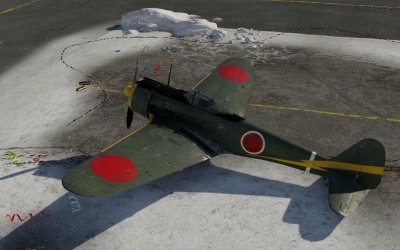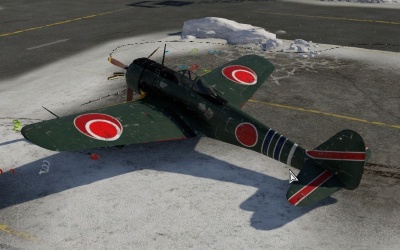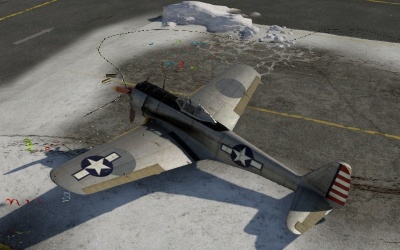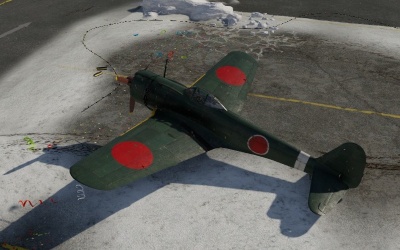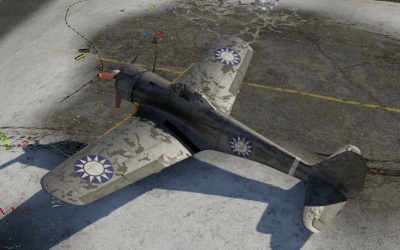Difference between revisions of "Ki-43 (Family)"
m |
(Edits) |
||
| Line 1: | Line 1: | ||
| − | |||
| − | |||
==Description== | ==Description== | ||
| − | The '''Nakajima Ki-43''' officially designated '''Army Type 1 Fighter''' | + | The '''Nakajima Ki-43''', officially designated '''Army Type 1 Fighter''', was the most numerous of all single-seat fighters used by the Imperial Japanese Army in World War II. While operating in Malaysia and Burma the plane received the codename "Jim" and in the Pacific Theatre it received the allied codename "Oscar". The codename "Oscar" was eventually selected as the official codename for the airplane by the Allies. |
| − | Nicknames | + | Nicknames: |
* ▅ - ''Hayabusa'' (隼, Peregrine Falcon) | * ▅ - ''Hayabusa'' (隼, Peregrine Falcon) | ||
* ▃ - ''Jim'' | * ▃ - ''Jim'' | ||
* ▃ - ''Oscar'' | * ▃ - ''Oscar'' | ||
| − | |||
==Development History== | ==Development History== | ||
| − | In early 1937 the Army recognized the need for a new single seat fighter. Instead of going through the normal process of requesting manufacturers to submit designs, the Army contracted with Nakajima directly to produce a replacement for their Ki-27 (Army Type 97) fighter. The requirements laid out to Nakajima for this new fighter was for it to have a top speed of 311 mph, to be able to reach 16,405 ft within five minutes, to have a minimum range of 500 miles, it was to be armed with two 7.7 mm machine guns, and to not lose any of the | + | In early 1937 the Army recognized the need for a new single seat fighter. Instead of going through the normal process of requesting manufacturers to submit designs, the Army contracted with Nakajima directly to produce a replacement for their Ki-27 (Army Type 97) fighter. The requirements laid out to Nakajima for this new fighter was for it to have a top speed of 311 mph, to be able to reach 16,405 ft within five minutes, to have a minimum range of 500 miles, it was to be armed with two 7.7 mm machine guns, and to not lose any of the manoeuvrability of the Ki-27. The first prototype of what was to become the Ki-43 was completed in December 1938 with 2 more following soon after in 1939, however upon testing it was found that these airplanes did not live up the Army's expectations. The complaints from test pilots included that the plane was not manoeuvrable enough, hard to control, and had visibility issues. |
| − | Following the evaluation of the initial 3 prototypes, Nakajima would develop 10 testing aircraft with various modifications in order to address the armies concerns with the initial 3 prototypes. The changes tested included giving the fighter the more powerful HA-105 engine, replacing the 7.7 mm machine guns with 12.7 mm machine guns, upgrading the outer skin to a treated duralumin, narrower fuselage, redesigned tail surfaces, modifications to the wing design, and the introduction of butterfly flaps. The last improvement in particular helped the plane to overcome its lack of | + | Following the evaluation of the initial 3 prototypes, Nakajima would develop 10 testing aircraft with various modifications in order to address the armies concerns with the initial 3 prototypes. The changes tested included giving the fighter the more powerful HA-105 engine, replacing the 7.7 mm machine guns with 12.7 mm machine guns, upgrading the outer skin to a treated duralumin, narrower fuselage, redesigned tail surfaces, modifications to the wing design, and the introduction of butterfly flaps. The last improvement in particular helped the plane to overcome its lack of manoeuvrability that the Army had issue with. |
==Vehicles== | ==Vehicles== | ||
| Line 21: | Line 18: | ||
|- style="vertical-align:top;" | |- style="vertical-align:top;" | ||
| | | | ||
| − | [[File:Ki-43-1.jpg|400px|thumb|left | + | [[File:Ki-43-1.jpg|400px|thumb|left]] |
===[[Ki-43-I]]=== | ===[[Ki-43-I]]=== | ||
| − | After the 10 improved prototypes were tested the Army settled on what they saw was the optimum configuration and requested that the production aircraft be equipped with the Nakajima Ha-25 engine. The final design entered production as the Ki-43-Ia (Army Type 1 Fighter Model 1A) with the first example completing production in April 1941. This model was soon replaced with the Ki-43-Ib (Army Type 1 Fighter Model 1B) which replaced one of the 7.7 mm machine guns with a 12. | + | After the 10 improved prototypes were tested the Army settled on what they saw was the optimum configuration and requested that the production aircraft be equipped with the Nakajima Ha-25 engine. The final design entered production as the Ki-43-Ia (Army Type 1 Fighter Model 1A) with the first example completing production in April 1941. This model was soon replaced with the Ki-43-Ib (Army Type 1 Fighter Model 1B) which replaced one of the 7.7 mm machine guns with a 12.7 mm machine gun which was also soon replaced by the Ki-43-Ic (Army Type 1 Fighter Model 1C) which was equipped with two 12.7 mm machine gun. |
<br><br> | <br><br> | ||
|- style="vertical-align:top;" | |- style="vertical-align:top;" | ||
| | | | ||
| − | [[File:KI-43-II.jpg|400px|thumb|left | + | [[File:KI-43-II.jpg|400px|thumb|left]] |
===[[Ki-43-II]]=== | ===[[Ki-43-II]]=== | ||
| Line 35: | Line 32: | ||
|- style="vertical-align:top;" | |- style="vertical-align:top;" | ||
| | | | ||
| − | [[File:KI-43-II USA.jpg|400px|thumb|left | + | [[File:KI-43-II USA.jpg|400px|thumb|left]] |
==={{Specs-Link|ki_43_2_late}}=== | ==={{Specs-Link|ki_43_2_late}}=== | ||
| − | In late 1942 the Australian Army managed to capture a intact example of a Ki-43 while fighting the Japanese Army in Papua New Guinea. It was quickly shipped back to Australia for testing where it ended up in the hands of the Technical Air Intelligence Unit who managed to repair it using parts from downed airplanes. It was painted in US livery and was used | + | In late 1942, the Australian Army managed to capture a intact example of a Ki-43 while fighting the Japanese Army in Papua New Guinea. It was quickly shipped back to Australia for testing where it ended up in the hands of the Technical Air Intelligence Unit who managed to repair it using parts from downed airplanes. It was painted in US livery and was used to test its performance against Allied planes. After testing by the Technical Air Intelligence Unit it was shipped to the United States for further evaluations. |
<br><br> | <br><br> | ||
|- style="vertical-align:top;" | |- style="vertical-align:top;" | ||
| | | | ||
| − | [[File:Ki-43-III.jpg|400px|thumb|left | + | [[File:Ki-43-III.jpg|400px|thumb|left]] |
===[[Ki-43-III otsu]]=== | ===[[Ki-43-III otsu]]=== | ||
| − | The last major modification of the Ki-43 was done in 1944, combining the minor modifications of the IIa and IIb with the more powerful Nakajima Ha-115-II engine. These minor modifications over the Ki-43-II included a reduced wing-span (improving the plane's low and medium speed performance), increased pilot armour, improved oil cooler, and modified carburetor intake. This new Ki-43-IIIa (Army Type 1 Fighter Model 3A) entered production in October 1944 with approximately 1,000 being completed before the war ended. | + | The last major modification of the Ki-43 was done in 1944, combining the minor modifications of the IIa and IIb with the more powerful Nakajima Ha-115-II engine. These minor modifications over the Ki-43-II included a reduced wing-span (improving the plane's low and medium speed performance), increased pilot armour, improved oil cooler, and modified carburetor intake. This new Ki-43-IIIa (Army Type 1 Fighter Model 3A) entered production in October 1944 with approximately 1,000 being completed before the war ended. |
<br><br> | <br><br> | ||
|- style="vertical-align:top;" | |- style="vertical-align:top;" | ||
| | | | ||
| − | [[File:Ki-43-III China.jpg|400px|thumb|left | + | [[File:Ki-43-III China.jpg|400px|thumb|left]] |
==={{Specs-Link|ki_43_3_ko}}=== | ==={{Specs-Link|ki_43_3_ko}}=== | ||
| − | After the end of the war, a number of nations used the Ki-43, including the Indonesian People's Security Force who used them against the Dutch, and the French who used them against Communist forces in Indochina. One such post war user was the Nationalist Chinese Air Forces who operated captured | + | After the end of the war, a number of nations used the Ki-43, including the Indonesian People's Security Force who used them against the Dutch, and the French who used them against Communist forces in Indochina. One such post-war user was the Nationalist Chinese Air Forces who operated captured Ki-43 in the 6th group. These saw use against the Communist Chinese forces in the Chinese Civil War and 5 were eventually captured and used by the Chinese Communist Air Force until 1952. |
<br><br> | <br><br> | ||
|} | |} | ||
Revision as of 15:45, 23 December 2020
Contents
Description
The Nakajima Ki-43, officially designated Army Type 1 Fighter, was the most numerous of all single-seat fighters used by the Imperial Japanese Army in World War II. While operating in Malaysia and Burma the plane received the codename "Jim" and in the Pacific Theatre it received the allied codename "Oscar". The codename "Oscar" was eventually selected as the official codename for the airplane by the Allies.
Nicknames:
- ▅ - Hayabusa (隼, Peregrine Falcon)
- ▃ - Jim
- ▃ - Oscar
Development History
In early 1937 the Army recognized the need for a new single seat fighter. Instead of going through the normal process of requesting manufacturers to submit designs, the Army contracted with Nakajima directly to produce a replacement for their Ki-27 (Army Type 97) fighter. The requirements laid out to Nakajima for this new fighter was for it to have a top speed of 311 mph, to be able to reach 16,405 ft within five minutes, to have a minimum range of 500 miles, it was to be armed with two 7.7 mm machine guns, and to not lose any of the manoeuvrability of the Ki-27. The first prototype of what was to become the Ki-43 was completed in December 1938 with 2 more following soon after in 1939, however upon testing it was found that these airplanes did not live up the Army's expectations. The complaints from test pilots included that the plane was not manoeuvrable enough, hard to control, and had visibility issues.
Following the evaluation of the initial 3 prototypes, Nakajima would develop 10 testing aircraft with various modifications in order to address the armies concerns with the initial 3 prototypes. The changes tested included giving the fighter the more powerful HA-105 engine, replacing the 7.7 mm machine guns with 12.7 mm machine guns, upgrading the outer skin to a treated duralumin, narrower fuselage, redesigned tail surfaces, modifications to the wing design, and the introduction of butterfly flaps. The last improvement in particular helped the plane to overcome its lack of manoeuvrability that the Army had issue with.
Vehicles
Ki-43-IAfter the 10 improved prototypes were tested the Army settled on what they saw was the optimum configuration and requested that the production aircraft be equipped with the Nakajima Ha-25 engine. The final design entered production as the Ki-43-Ia (Army Type 1 Fighter Model 1A) with the first example completing production in April 1941. This model was soon replaced with the Ki-43-Ib (Army Type 1 Fighter Model 1B) which replaced one of the 7.7 mm machine guns with a 12.7 mm machine gun which was also soon replaced by the Ki-43-Ic (Army Type 1 Fighter Model 1C) which was equipped with two 12.7 mm machine gun.
|
Ki-43-IIAfter some time in the field, the Ki-43 was to receive a major upgrade based on feedback from pilots, which included replacing the Ha-25 engine with the more powerful Ha-115 engine, a two stage supercharger, pilot armour, self-sealing fuel tanks and many more minor improvements. The first prototype of what was to become the Ki-43-II (Army Type 1 Fighter Model 2) was completed in February 1942.
|
▃Ki-43-IIIn late 1942, the Australian Army managed to capture a intact example of a Ki-43 while fighting the Japanese Army in Papua New Guinea. It was quickly shipped back to Australia for testing where it ended up in the hands of the Technical Air Intelligence Unit who managed to repair it using parts from downed airplanes. It was painted in US livery and was used to test its performance against Allied planes. After testing by the Technical Air Intelligence Unit it was shipped to the United States for further evaluations.
|
Ki-43-III otsuThe last major modification of the Ki-43 was done in 1944, combining the minor modifications of the IIa and IIb with the more powerful Nakajima Ha-115-II engine. These minor modifications over the Ki-43-II included a reduced wing-span (improving the plane's low and medium speed performance), increased pilot armour, improved oil cooler, and modified carburetor intake. This new Ki-43-IIIa (Army Type 1 Fighter Model 3A) entered production in October 1944 with approximately 1,000 being completed before the war ended.
|
␗Ki-43-III koAfter the end of the war, a number of nations used the Ki-43, including the Indonesian People's Security Force who used them against the Dutch, and the French who used them against Communist forces in Indochina. One such post-war user was the Nationalist Chinese Air Forces who operated captured Ki-43 in the 6th group. These saw use against the Communist Chinese forces in the Chinese Civil War and 5 were eventually captured and used by the Chinese Communist Air Force until 1952.
|
| Nakajima Aircraft Company (中島飛行機株式会社 ) | |
|---|---|
| Fighters | Ki-27 otsu · Ki-27 otsu Tachiarai |
| Ki-43-I · Ki-43-II · Ki-43-III otsu | |
| Ki-44-I · Ki-44-I 34 · Ki-44-II otsu · Ki-44-II hei | |
| Ki-84 ko · Ki-84 otsu · Ki-84 hei | |
| Ki-87 | |
| Hydroplanes | A6M2-N* |
| Interceptors | J1N1 · J5N1 |
| Bombers | B5N2 |
| B6N1 Model 11 · B6N2 Model 12 · B6N2a Model 12Ko | |
| G5N1 · G8N1 | |
| Ki-49-I · Ki-49-IIa · Ki-49-IIb · Ki-49-IIb/L | |
| Recon | E8N2 |
| Jet Fighters | Kikka |
| Captured | ␗Ki-27 otsu · ▃Ki-43-II · ␗Ki-43-III ko · ␗Ki-44-II hei · ␗Ki-84 ko |
| *Refit of the Mitsubishi A6M2 mod. 11 | |
| See also | Fuji Heavy Industries (1957-2017) |
| Japan fighters | |
|---|---|
| Navy | |
| Carrier-based fighter | |
| A5M | A5M4 · Hagiri's A5M4 |
| A6M | A6M2 mod. 11 · A6M2 · A6M3 · A6M3 mod. 22 · A6M3 mod. 22Ko · A6M5 · A6M5 Ko · A6M5 otsu · A6M5 Hei · A6M6c |
| A7He | A7He1* |
| A7M | A7M1 (NK9H) · A7M2 |
| Land-based Fighter | |
| J2M | J2M2 · J2M3 · J2M4 Kai · J2M5 · J2M5 (30 mm) |
| J6K | J6K1 |
| J7W | J7W1 |
| N1K-J | N1K1-Ja · N1K2-J · N1K2-Ja |
| Fighter seaplane | |
| N1K | N1K1 |
| A6M-N | A6M2-N |
| Army | |
| Ki-10 | Ki-10-I · Ki-10-I C · Ki-10-II · Ki-10-II C |
| Ki-27 | Ki-27 otsu · Ki-27 otsu Tachiarai |
| Ki-43 | Ki-43-I · Ki-43-II · Ki-43-III otsu |
| Ki-44 | Ki-44-I · Ki-44-I 34 · Ki-44-II otsu · Ki-44-II hei |
| Ki-61 | Ki-61-I ko · Ki-61-I otsu · Ki-61-I hei · Tada's Ki-61-I hei · Ki-61-I tei · Ki-61-II Otsu Kai |
| Ki-84 | Ki-84 ko · Ki-84 otsu · Ki-84 hei |
| Ki-87 | Ki-87 |
| Ki-94 | Ki-94-II |
| Ki-100 | Ki-100 · Ki-100-II |
| Other countries | ▅F4U-1A · ▅P-51C-11-NT · ▅Bf 109 E-7 · ▅Fw 190 A-5 |
| *Imported designation of the He 112 (A6M was in development - A7M would take A7 designation after the cancelation of the A7He) | |


